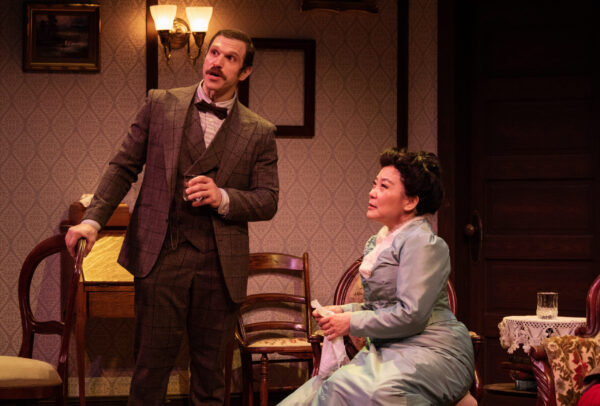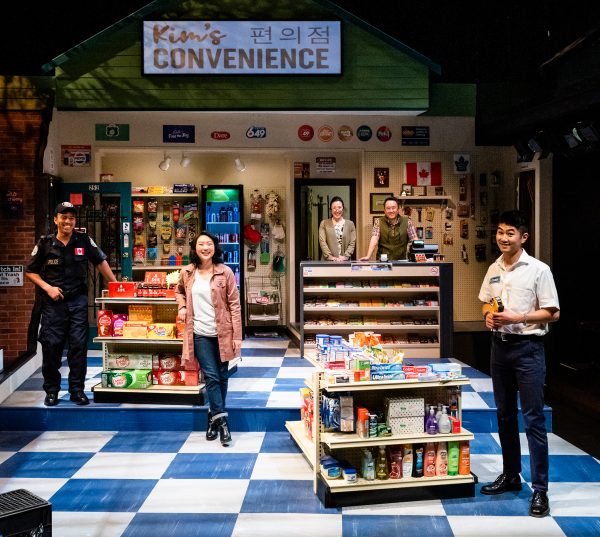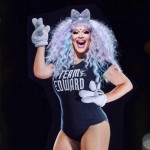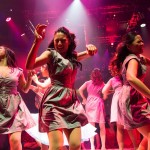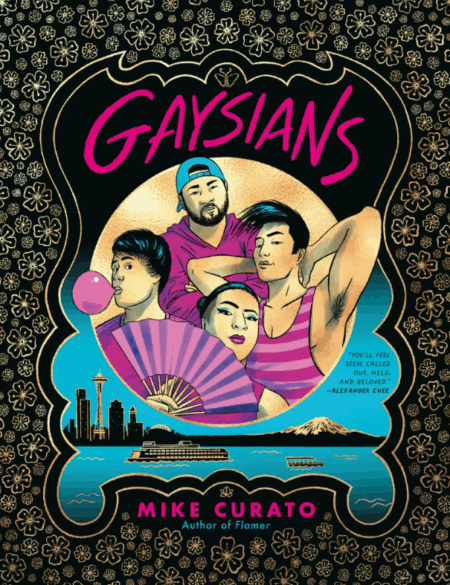New plays are the ultimate theatrical gamble. Are they ready for Broadway or do they need to go back to the workshop for another rewrite…or, two?
(Alternate opener: What do you do when you like the promotional photos/artwork better than the productions themselves?)

Is it a new play or a new post-apocalyptic series on Netflix? It’s the cast of WELLESLEY GIRL a new play from The Horse in Motion. Photo: Colby Wood.
Review: Wellesley Girl by Brendan Pelsue. Produced by The Horse in Motion. Directed by Bobbin Ramsey. Scenic Design by Brandon Estrella. Costume Design by Jenn Oaster. Lighting Design by Ryan Dunn. Sound Design by Alex Potter. With Sunam Ellis, Joseph Shaw, Shaudi Bianca Vahdat, Laura Steele, Mario Orallo-Molinaro, Ben Phillips, Nic Morden. Now through April 29, 2017 at 18th & Union.
The Horse in Motion company, an interesting young collaborative group made up of recent-ish grads from the University of Washington Drama Program is staging the West Coast premiere of a new-ish play. It’s Brendan Pelsue’s WELLESLEY GIRL, a two act drama set in the semi-distant future after cataclysmic events have decimated our planet and seemingly caused the collapse of modern civilization.
FUN!
As suggested by the title, it’s set in the nicer western suburbs of Boston, home to numerous colleges and scientific enterprises and focuses on what we are led to believe are the last remnants of the United States of America, a trio of towns surrounded by a wall where things are ruled by a President, a Congress and a Supreme Court and all decisions are made in congressional meetings. But, the community is small and every adult is a member of Congress and since there’s only one remaining lawyer, their Supreme Court consists of that one surviving attorney…who issues decisions in between laundry loads.
Life has been fairly benign for the last few years for the enclave but there are troubles a’brewin’… Some townspeople are eager to branch out past the walls of their society to settle in the “forbidden” outside world but there are fears of ecological dangers, including a potentially lethal water supply and the sudden presence of alien troupes outside their walls. The play centers on one woman, Marie, who is one of the only survivors of a former part of their enclave, the town of Wellesley which fell victim to the polluted water many years before when Marie was a child. She’s now a married mother of two sons and she’s adamantly (and a tad hysterically) opposed to venturing out into the unknown world…even after the Congress votes for a “Scorched Earth Policy” to deal with the invading troupes who are demanding that this society join up with their own. Marie, who is the “Wellesley Girl” of the title is willing to make the ultimate sacrifice to protect her family from that decision, even if it proves fatal.
That, in a nutshell is the plot of “Wellesley Girl”…it’s primarily Marie’s story but we also spend some time with the President of the “U.S.” a woman named Garth (not sure why she is named Garth; perhaps it’s gender blind casting??) who’s the very ineffectual leader of this group who also has a “robot” husband named Hank (who is actually an android because..uh, androids look like humans and robots look like…robots). Garth still has feelings for Marie’s equally ineffectual husband Max, who’s basically a door mat with cute hair. Meanwhile, there’s Scott who’s the motormouth/know it all in Congress who keeps interrupting every other speaker when he wants to make his blowhard speeches and RJ another wishy washy character who really serves very little purpose other than as a “Red Shirt” to be disposed of when the plot tires of his presence. Oh, and there’s Donna the nice homespun Chief/Only Justice of the Supreme Court who balances a heavy case load of jurisprudence with fluffing and starching her fine washables and household linens.
I guess “Wellesley Girl” is…allegorical? Dystopic? Satirical? Dramatic? Melodramatic? All or some of the above? It’s actually unclear at times since the tone varies so much which is partly the writing and partly the tone of this production which bounces between rather dull government meeting scenes (fun I suppose…if you enjoy C-Span) and rather banal soap opera-y dialogue where the characters constantly refer to each other by name (“Garth…I can’t love you. I’m married to Marie. You’re married to an android named Hank…the Algae Bloom menace is threatening our lives and Scott threatens to under mind your authority as President while he pursues a clandestine relationship with…”)
This script didn’t work for me. It either needs to be soapier or play up the speculative fiction stuff but the “moral dilemma” high drama is frankly a bit long winded and depressing mainly because Marie is such a Debbie Downer of a character. She’s the Ibsen character dropped into the middle of “All My Circuits”.
That said, the actress playing Marie is the best thing in the play. Sunam Ellis gives a terrific performance in the role of a character I kind of despise. She’s fiercely connected to the material and it’s a strong, passionate performance. I just can’t get over the character’s “Medea” like desires to solve her woes…
There’s plenty of other things to admire here, too. Nic Morden was amusing as the Android Husband (who’s frankly treated shabbily by his annoying wife…) I liked Donna Steele as the plainspoken Chief Justice. Brandon Estrella and Ryan Dunn and Jenn Oaster have lovely designs in this show (Set, Lights, Costume respectively though I was slightly confused by the fact this society has the technology for washing machines and driers but also feel compelled to sew their clothes with blanket stitches…) Bobbin Ramsey has a sure hand at directing small moments in shows…there’s always a fine attention to detail.
I can’t say that the small pleasures of “Wellesley Girl” can override the clunky nature of its script (which doesn’t always make much logical sense, even for speculative fiction) but if you appreciate this theater company and quirky plays in general, it might be a good fit.
Review: Nadeshiko by Keiko Green. Produced by Sound Theatre Company. Directed by Kaytlin McIntyre. Scenic Design by Catherine Cornell. Costume Design by Hannah Larson. Lighting Design by Richard Schaefer. Sound Design by Dana Amromin. Video Design by Luke Walker and MJ Sieber. Props Design by Brandon Estrella and Wendy Hanson. With Maile Wong, Mi Kang, Ina Chang, Josh Kenji, Greg Lyle-Newton. Now through May 6, 2017 at Center Theatre/Seattle Center.
The other new play in town is a world premiere as well as a homegrown/made in Seattle play. It’s Sound Theatre Company’s production of local actress/playwright Keiko Green’s NADESHIKO which examines different aspects of the concept of “the personification of an idealized Japanese woman” but also used here by Ms Green to expand that meaning to include the fetishization of Asian women in general both in Asian and Western cultures.
But, there are other meanings to the word as well…nadeshiko is also a fragile pink flower. And, the word was applied to a cadre of young women who took care of kamikaze pilots in Japan during the waning days of World War II, cleaning their rooms and taking care of their uniforms, before the men left on their suicide missions.
Green’s work here is actually two plays linked by a framing device. The play opens with Risa, a modern young Japanese American woman around 21 or so, entering the home of a 50 year old white man. Risa, who has recently lost her job and needs money, has found this gig via Craigslist and it seems the man wants to pay her for a vaguely unspecified act of fetishization involving Risa reading him a novel while sitting in a chair. Despite the fact the act doesn’t seem overtly sexual, Risa panics and runs out of the man’s apartment still holding the $300 he was paying her. She runs to her wiser street smart cousin Sue, who she grew up with, for some sensible advice. Sue is supporting herself by taking advantage of her “nadeshiko-ness” by performing on sex websites catering to men who seek out Asian women. Not all of Sue’s clients want sexual acts or even nudity; many actually want her to perform other kinds of fetishism (feet, S/M) to sate their desire. Sue counsels Risa to seek other work; she doesn’t think her cousin is cut out for it, and it seems she’s right because Risa commits the ultimate sex worker no-no, she reconnects with a former client by showing up unannounced at his condo.
The “White Haired Man” as he is credited, is a bit annoyed but also seemingly pleased by Risa’s return. He’s basically a nice guy, lonely, and eager to replicate an incident from when he was younger and was involved in a relationship with a Japanese woman while he was living in Asia. Soon, the two form an odd relationship that isn’t traditional in any sense of the word as each of the pair seek out something offered by the other.
Tying these scenes together is the presence of a character called “Nadeshiko”…it’s an elderly Japanese woman speaking in “funny” broken English who seems aware she’s performing in a play (or some kind of limbo) in front of an audience. She’s not sure if she’s dreaming or dead but she seems anxious to break free of this purgatory…though her wise cracks and deadpan humor don’t really seem to indicate that she’s in that much distress.
The “ghostly granny” does indicate she was a nadeshiko girl during WW II and at the end of the first act indicates we will see THAT story in the second half of the play which does indeed pick up in Japan at the end of the war with “young Nadeshiko” (played by the actress playing the worldly Sue in the modern scenes) growing attached to a young pilot named Toshio before he flies off to his death. The rest of the second act deals with the fate of Risa, Sue and White Haired Man before leading to a final moment that is…
Enraging.
“Nadeshiko: The Play” is full of some clever ideas…but, structurally, it’s a major mess. There’s the main story line, “The Misadventures of Risa” which has a somewhat interesting premise as it examines a young modern Asian-American woman coping with her young modern Asian-American woman’s life. But, the actual World War II flashback scenes don’t really feel very connected at all with the main story…they’re just plunked into Act 2 and never integrate with anything else going on. And, the linking device of “Funny Asian Granny” is funny, but only up to a point because if you think too much about it, the character is a bit of a cliché on a par with “Sassy Black Woman” and “Campy Gay Dude”.
There’s also the issue of a lead character who is frankly not the slightest bit likable. Risa is loud, annoying, a tad devoid of common sense and ultimately she’s a condescending little brat. No one is saying a leading character in a play/book/film has to be adorable; in fact literature is loaded with anti-heroes that can be complete jerks, but great “awful” characters are written so you want to spend some time with them. The problem here is, Risa is such a pill of a person I don’t want to spend ANY time with her. She wears out her welcome about 25 minutes into Act One.
And, to be honest, it’s not just the writing. Kaytlin McIntyre’s direction here isn’t very assured in some of the scenes. There are some nice nuances in that awkward opening with Risa navigating her way through the emotional landmines of her initial encounter with White Haired Man; actually, it’s the best scene in the entire production. That opening gave me some hope because the writing is strong here and both Maile Wong, as Risa, and Greg Lyle-Newton as White Haired Man give intelligent fully realized performances in these opening moments.
But things start to fall apart when Risa meets up with cousin Sue because these scenes are too loud with both actors way over the top in their performances. It’s just two twentysomething millennials screeching their way through a conversation…it’s like being on a Metro bus in the U-District at 1am. There is similar lack of directorial control in the WW II scenes that are very awkwardly staged and acted. Here, there’s also issues with the writing as well since the dialogue between the young Nadeshiko and the Pilot feels like it’s been ripped from a WB teen drama; nothing about it feels like two teenagers in 1945 Japan having a dialogue. People in 1945 (even teenagers) didn’t talk as colloquially and slangy as we do today and these scenes just feel awkward and phony.
As for the ending…it enraged me because the play ends with Risa being condescending towards the White Haired Man character who frankly, has done nothing to earn her ire. If the play (and I assume the playwright) is going to be “pro-sex worker” as an honest professional option for a woman, I’m confused why the character and the play take on a tone of “anti-men who hire sex workers as disingenuous perverts”. Risa is the character who makes the odd choice to return to a client’s house and explore a non-sexual relationship with him and impose herself on his life. She’s the character displaying irrational behavior…yet we’re supposed to feel empathy for her as a victim of Asian fetishization? Why? She’s basically a stalker with Daddy and Boundary Issues.
This play does have some strong moments, especially that interesting opening scene, and it has fine scenic design from Catherine Cornell and Richard Schaefer’s lights. Ina Chang is very funny in what is essentially a stereotypical role and as stated earlier, Greg Lyle-Newton is restrained and compassionately present in his work here as the White Haired Man. Mi Kang, so excellent last fall in Book-It’s “A Tale of the Time Being” is less compelling here in a weaker script/direction but her work as Sue is an interesting counterpart to that earlier performance. Maile Wong in the lead role suffers under the inadequacies of script/direction/the awfulness of her character but I did think she had a handle on the weaknesses of that character. She is compelling despite the limits of the character and the story.
Keiko Green displayed strong writing skills with her previous play, a collaboration with Bret Fetzer, the charming “A Day in the Life of Comicon” play “Puny Humans” last year at Annex. She has a future as a playwright and there are ideas in “Nadeshiko: The Play” worth exploring in future rewrites of the material. Like Ms Green herself, it has potential.




